Electricity Demand Forecasting of Hospital Buildings in Istanbul
Abstract
:1. Introduction
2. Hospital Data and Analysis Methods
2.1. Hospital Data
2.1.1. Demand Factor
2.1.2. Coincidence Factor
2.2. Methods
3. Results
3.1. Formula 1
3.2. Formula 2
3.3. Cost-Saving Implications
4. Discussion
4.1. The Effect of Hospital Typology
4.2. The Effect of Considering a Limited Number of Hospitals
5. Conclusions
Author Contributions
Funding
Institutional Review Board Statement
Data Availability Statement
Acknowledgments
Conflicts of Interest
Abbreviations
| CF | Coincidence factor |
| DF | Demand Factor |
| MD | Maximum demand |
| MSE | Mean Squared Error |
| MAPE | Mean Absolute Percentage Error |
| MAPD | Mean Absolute Percentage Deviation |
| R&T | Training and research |
| RMSE | Root Mean Squared Error |
| SC | System Capacity |
References
- Kasule, A.; Ayan, K. Forecasting Uganda’s Net Electricity Consumption Using a Hybrid PSO-ABC Algorithm. Arab. J. Sci. Eng. 2019, 44, 3021–3031. [Google Scholar] [CrossRef]
- Mohamed, Z.; Bodger, P. Forecasting electricity consumption in New Zealand using economic and demographic variables. Energy 2005, 30, 1833–1843. [Google Scholar] [CrossRef] [Green Version]
- Kavaklioglu, K.; Ceylan, H.; Ozturk, H.K.; Canyurt, O.E. Modeling and prediction of Turkey’s electricity consumption using artificial neural networks. Energy Convers. Manag. 2009, 50, 2719–2727. [Google Scholar] [CrossRef]
- Morgül Tumbaz, M.N.; İpek, M. Energy Demand Forecasting: Avoiding Multi-collinearity. Arab. J. Sci. Eng. 2021, 46, 1663–1675. [Google Scholar] [CrossRef]
- Toksarı, D.M. Ant colony optimization approach to estimate energy demand of Turkey. Energy Policy 2007, 35, 3984–3990. [Google Scholar] [CrossRef]
- Kankal, M.; Akpınar, A.; Kömürcü, M.I.; Özşahin, T.Ş. Modeling and forecasting of Turkey’s energy consumption using socio-economic and demographic variables. Appl. Energy 2011, 88, 1927–1939. [Google Scholar] [CrossRef]
- Oğcu, G.; Demirel, O.F.; Zaim, S. Forecasting electricity consumption with neural networks and support vector regression. Procedia Soc. Behav. Sci. 2012, 58, 576–1585. [Google Scholar] [CrossRef] [Green Version]
- Kiran, M.S.; Özceylan, E.; Gündüz, M.; Paksoy, T. Swarm intelligence approaches to estimate electricity energy demand in Turkey. Knowl. Based Syst. 2012, 36, 93–103. [Google Scholar] [CrossRef]
- Bertolini, S.; Massucco, S.; Silvestro, F.; Grillo, S.; Giacomini, G. Short-Term Load Forecasting in Hospital Systems. In IFMBE Proceedings, Proceedings of the World Congress on Medical Physics and Biomedical Engineering, Beijing, China, 26–31 May 2012; Long, M., Ed.; Springer: Berlin/Heidelberg, Germany, 2013; Volume 39. [Google Scholar] [CrossRef]
- Cao, L.; Li, Y.; Zhang, J.; Jiang, Y.; Han, Y.; Wei, J. Electrical load prediction of healthcare buildings through single and ensemble learning. Energy Rep. 2020, 6, 2751–2767. [Google Scholar] [CrossRef]
- Morinigo-Sotelo, D.; Duque-Perez, O.; Garcia-Escudero, L.A.; Fernandez-Temprano, M.; Fraile-Llorente, P.; Riesco-Sanz, M.V.; Zorita-Lamadrid, A.L. Short-Term Hourly Load Forecasting of a Hospital Using an Artificial Neural Network. In Proceedings of the International Conference on Renewable Energies and Power Quality, Las Palmas de Gran Canaria, Spain, 13–15 April 2011; pp. 441–446. [Google Scholar]
- Bagnasco, A.; Saviozzi, M.; Silvestro, F.; Vinci, A.; Grillo, S.; Zennaro, E. Artificial Neural Network Application to Load Forecasting in a Large Hospital Facility. In Proceedings of the International Conference on Probabilistic Methods Applied to Power Systems (PMAPS), Durham, UK, 7–10 July 2014; pp. 1–6. [Google Scholar]
- Bagnasco, A.; Fresi, F.; Saviozzi, M.; Silvestro, F.; Vinci, A. Electrical Consumption Forecasting in Hospital Facilities: An Application Case. Energy Build. 2015, 103, 261–270. [Google Scholar] [CrossRef]
- World Health Organization. 2017. Available online: http://www.who.int/hospitals/en/ (accessed on 9 January 2021).
- Istanbul Health Directorate. 2021. Available online: www.istanbulsaglik.gov.tr/w/sb/tedk/belge/Devlet_Hastaneleri.pdf (accessed on 9 January 2021).
- Katsanis, J.S.; Malahias, G.N.; Koustellis, J.D.; Halaris, P.G. Electrical Energy Consumptions in Hospitals—The Case of Lifts. In Proceedings of the Power and Energy Systems Europes—IASTED International Conference, Crete, Greece, 22–24 June 2011. [Google Scholar]
- Becker’s Hospital Review. 2012. Available online: http://www.beckershospitalreview.com/strategic-planning/18-statistics-on-hospital-energy-consumption.html (accessed on 9 January 2021).
- Katsanis, J.S.; Tsarabaris, P.T.; Koufakis, E.I.; Polykrati, A.; Proios, A.N. An energy saving system for hospital laundries. In Proceedings of the Power and Energy Systems Europes—IASTED International Conference, Palma de Mallorca, Spain, 7–9 September 2009. [Google Scholar]
- Balaras, C.A.; Gaglia, A.G.; Georgopoulou, E.; Mirasgedis, S.; Sarafidis, Y.; Lalas, D.P. European residential buildings and empirical assessment of the Hellenic building stock, energy consumption, emissions and potential energy savings. Build. Environ. 2007, 42, 1298–1314. [Google Scholar] [CrossRef]
- US Energy Information Administration. Commercial Buildings Energy Consumption Survey CBECS 2007; US Energy Information Administration: Washington, DC, USA, 2012.
- Neal, B. Spec’ing Hospital Electrical Distribution System. Consult. Specif. Eng. 2013, 50, 22–27. [Google Scholar]
- Barros, O.; Weber, R.; Reveco, C.; Ferro, E.; Julio, C. Demand Forecasting and Capacity Management for Hospitals. 2011. Available online: https://www.researchgate.net/publication/274390870_Demand_Forecasting_and_Capacity_Management_for_Hospitals (accessed on 29 June 2021).
- Hu, S.; Chen, J.; Chuah, Y. Energy Cost and Consumption in a Large Acute Hospital. Int. J. Archit. Sci. 2004, 5, 11–19. [Google Scholar]
- Teke, A.; Timur, O.; Zor, K. Üniversite Hastanesinde Enerji Verimliliğini Artıran Uygulamaların Geri Dönüşüm Sürelerinin Hesaplanması. Çukurova Üniv. Mühendis. Mimar. Fak. Derg. 2015, 30, 41–56. [Google Scholar] [CrossRef] [Green Version]
- Altan, H.; Ozarisoy, B. An Analysis of the Development of Modular Building Design Elements to Improve Thermal Performance of a Representative High Rise Residential Estate in the Coastline City of Famagusta, Cyprus. Sustainability 2022, 14, 4065. [Google Scholar] [CrossRef]
- Faber, T.; Finkenrath, M. (2021). Load Forecasting in District Heating Systems Using Stacked Ensembles of Machine Learning Algorithms. In Proceedings of the 14th International Renewable Energy Storage Conference 2020 (IRES 2020), Dusseldorf, Germany, 10–12 March 2020. [Google Scholar] [CrossRef]
- Gordillo-Orquera, R.; Lopez-Ramos, L.; Muñoz-Romero, S.; Iglesias-Casarrubios, P.; Arcos-Aviles, D.; Marques, A.; Rojo-Álvarez, J. Analyzing and Forecasting Electrical Load Consumption in Healthcare Buildings. Energies 2018, 11, 493. [Google Scholar] [CrossRef] [Green Version]
- Hospital Contract Power; Anatolian Side of the Electricity Distribution Company: Istanbul, Turkey, 2020.
- Maximum Demand per Month; Boğaziçi Electricity Distribution Company: Istanbul, Turkey, 2020.
- Weedy, B. Electric Power Systems; Wiley: Southampton, UK, 1979. [Google Scholar]
- Şentürk, E. A New Aproach to Load Characteristics and Coincidence Factor in Residential Areas. Master’s Thesis, Department of Electrical and Electronic Engineering, Yildiz Technical University, Istanbul, Turkey, 1996. [Google Scholar]
- Pekiner, F.O. A New Approach to the Use of Load Characteristics of Urban Housing Loads; Elektromek: Bursa, Turkey, 1993. [Google Scholar]
- Turkey Official Gazette. Electricity Internal Facilities Regulation in Turkey; Official Gazette: Ankara, Turkey, 1984.
- National Electrical Codes; NFPA70; National Fire Protection Association: Quincy, MA, US, 2017.
- Unit Price Book; Turkey Electricity Distribution Company: Ankara, Turkey, 2020.

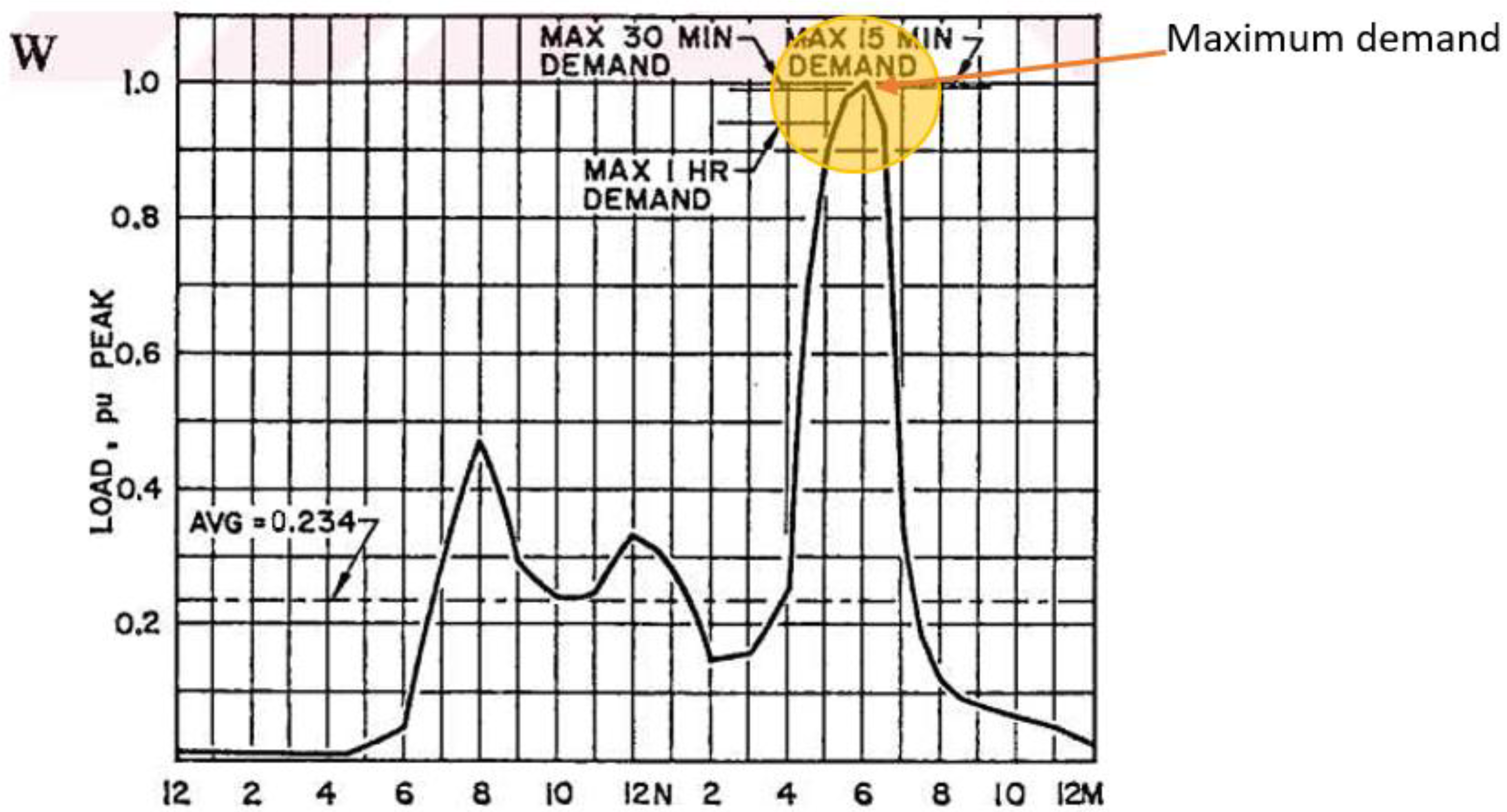

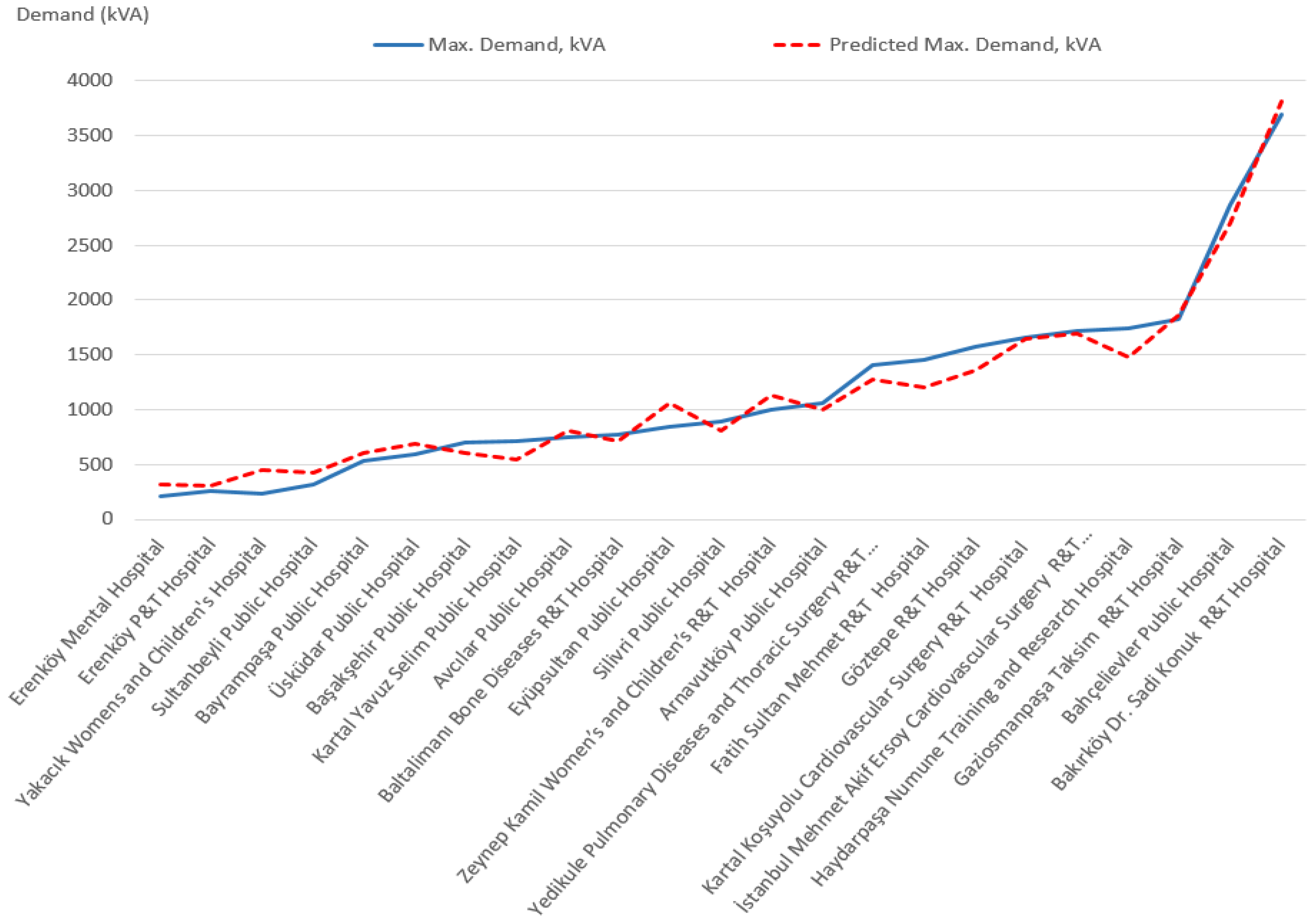
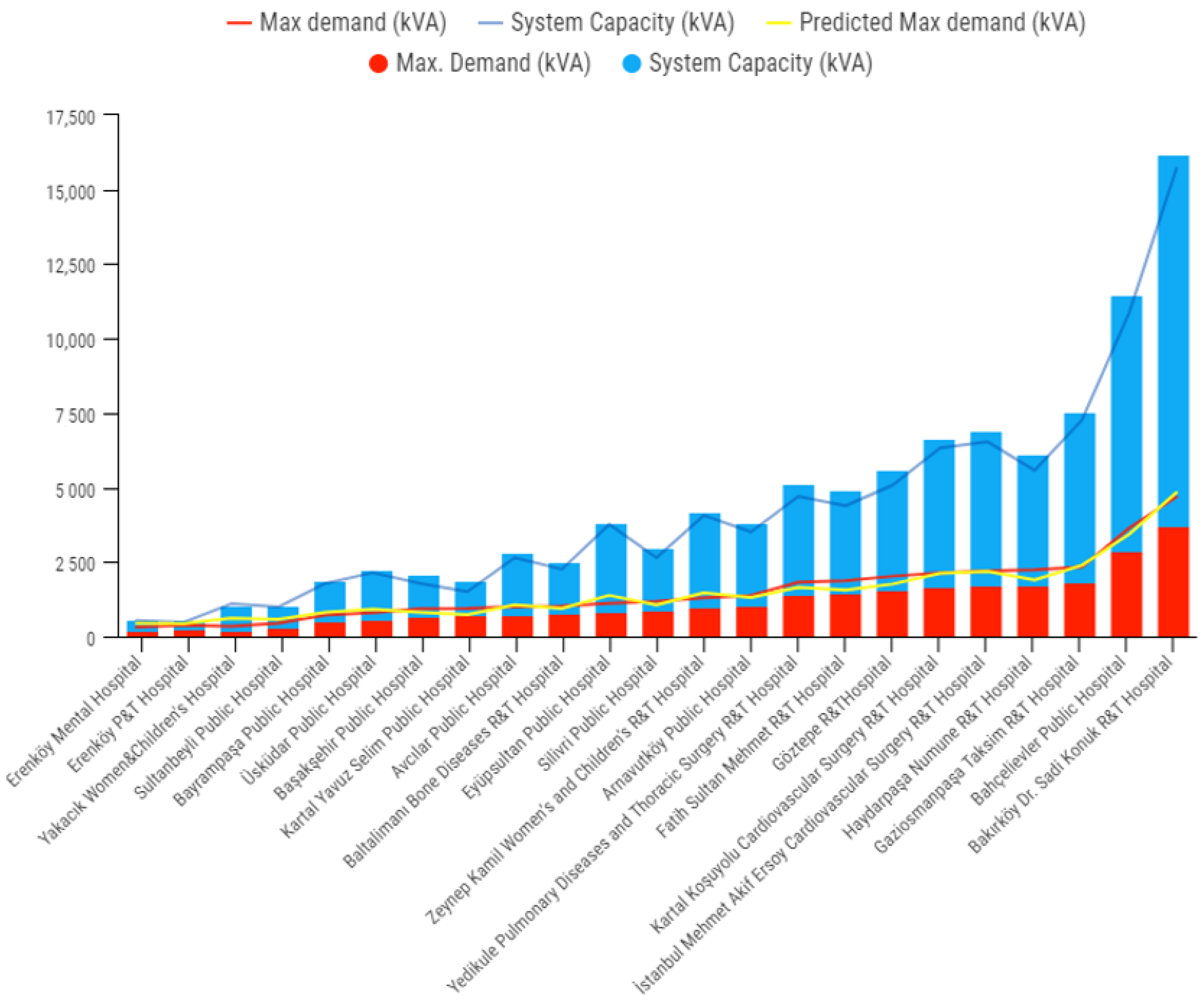



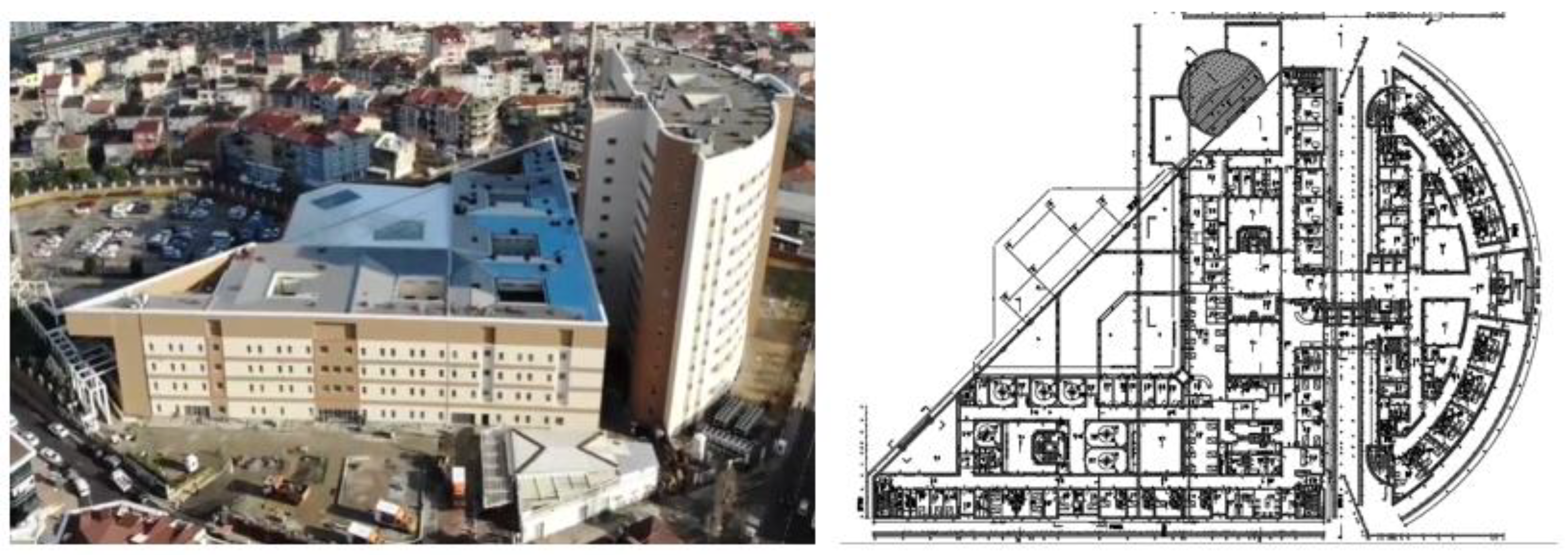
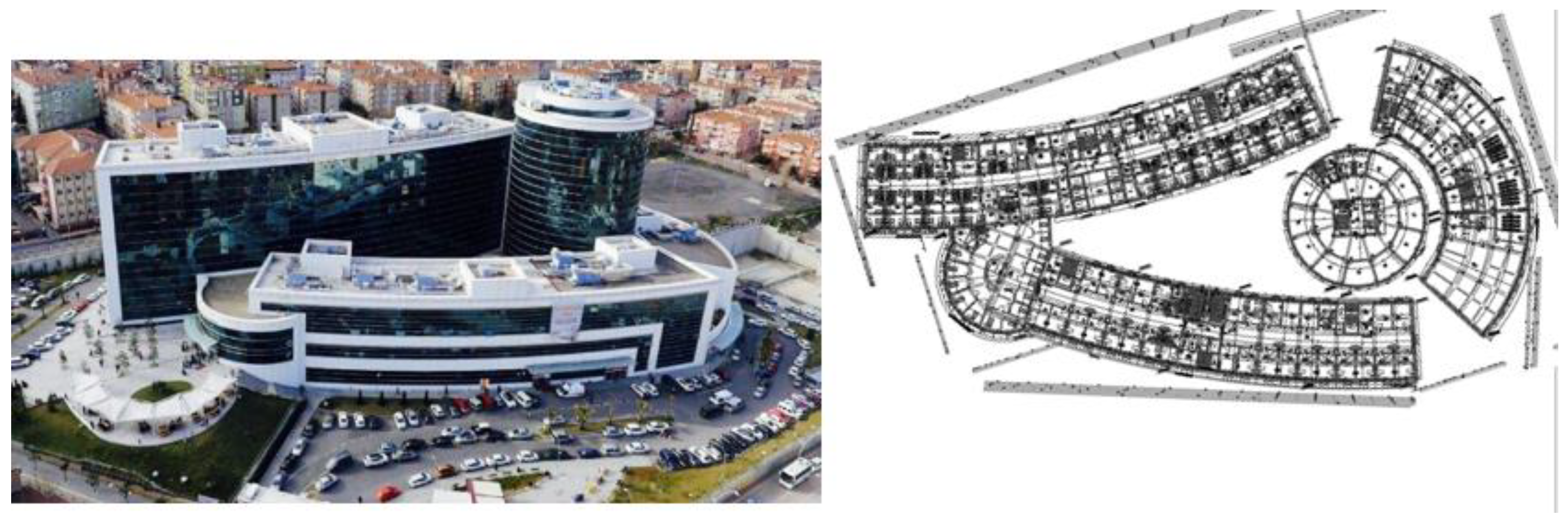


| Hospital Name | Bed | Area, m2 | System Capacity, kVA | Contract Power, kVA | Max. Demand, kVA |
|---|---|---|---|---|---|
| Haydarpaşa Numune R&T Hospital | 709 | 49,000 | 4401 | 3281 | 1745 |
| Göztepe R&T Hospital | 682 | 75,000 | 4010 | 2406 | 1572 |
| Bakırköy Dr. Sadi Konuk R&T Hospital | 612 | 66,900 | 12,480 | 6690 | 3697 |
| Zeynep Kamil Women’s and Children’s R&T Hospital | 501 | 29,700 | 3200 | 1920 | 994 |
| Kartal Koşuyolu Cardiovascular Surgery R&T Hospital | 465 | 39,950 | 5000 | 5000 | 1656 |
| Yedikule Pulmonary Diseases and Thoracic Surgery R&T Hospital | 333 | 37,115 | 3710 | 1760 | 1412 |
| Fatih Sultan Mehmet R&T Hospital | 300 | 41,670 | 3457 | 2075 | 1450 |
| Gaziosmanpaşa Taksim R&T Hospital | 300 | 61,600 | 5750 | 3732 | 1821 |
| Üsküdar Public Hospital | 263 | 15,830 | 1666 | 1000 | 597 |
| İstanbul Mehmet Akif Ersoy Cardiovascular Surgery R&T Hospital | 260 | 33,950 | 5175 | 2100 | 1718 |
| Kartal Public Hospital | 256 | 33,330 | 1158 | 695 | 708 |
| Erenköy Physical Therapy Hospital | 250 | 12,160 | 383 | 230 | 205 |
| Silivri Public Hospital | 223 | 15,820 | 2070 | 960 | 894 |
| Arnavutköy Public Hospital | 201 | 30,350 | 2760 | 1200 | 1059 |
| Eyüpsultan Public Hospital | 140 | 14,990 | 2960 | 1200 | 850 |
| Baltalimanı Bone Diseases R&T Hospital | 133 | 11,160 | 1760 | 980 | 774 |
| Bahçelievler Public Hospital | 125 | 57,610 | 8625 | 6400 | 2863 |
| Erenköy Mental Hospital | 101 | 11,735 | 337 | 337 | 262 |
| Avcılar Public Hospital | 100 | 18,727 | 2070 | 960 | 753 |
| Başakşehir Public Hospital | 100 | 11,800 | 1380 | 463 | 701 |
| Bayrampaşa Public Hospital | 100 | 12,965 | 1380 | 819 | 529 |
| Yakacık Women’s and children’s Hospital | 100 | 6600 | 833 | 500 | 234 |
| Sultanbeyli Public Hospital | 100 | 8375 | 750 | 450 | 315 |
| Building Type | Load | Coincidence Factor % |
|---|---|---|
| Coincidence factor for lighting load: | ||
| Hospitals | First 50 kVA | 40 |
| Hotels | After 50 kVA | 20 |
| First 20 kVA | 50 | |
| 20–100 kVA | 40 | |
| Warehouse | First 12.5 kVA | 100 |
| Other buildings | All | 100 |
| Coincidence factor for socket load: | ||
| All buildings | First 10 kVA | 100 |
| After 10 kVA | 50 | |
| Coincidence factor for elevators: | ||
| Office, Otels | 100 | |
| Schools, Hospitals | 85 | |
| Apartments, others | 55 | |
| Type of Occupancy | Portion of Lighting Load to Which Demand Factor Applies (Volt-Amperes) | Demand Factor (Percent) |
|---|---|---|
| Dwelling units | First 3000 or less at From 3001 to 120,000 at Remainder over 120,000 at | 100 35 25 |
| Hospitals * | First 50,000 or less at Remainder over 50,000 at | 40 20 |
| Hotels and motels, including apartment houses without provision for cooking by tenants * | First 20,000 or less at From 20,001 to 100,000 at Remainder over 100,000 at | 50 40 30 |
| Warehouses (storage) | First 12,500 or less at Remainder over 12,500 at | 100 50 |
| All others | Total volt-amperes | 100 |
| Type of Occupancy | Unit Load | |
|---|---|---|
| Volt-Amperes/m2 | Volt-Amperes/ft2 | |
| Armories and auditoriums | 11 | 1 |
| Banks | 39 b | 3 1/2 b |
| Barber shops and beauty parlors | 33 | 1 |
| Churches | 11 | 1 |
| Clubs | 22 | 2 |
| Courtrooms | 22 | 2 |
| Dwelling units | 33 | 2 |
| Garages-commercial (storage) | 6 | 1/2 |
| Hospitals | 22 | 2 |
| Hotels and motels, including apartment houses without provision for cooking by tenants a | 22 | 2 |
| Industrial commercial (loft) buildings | 22 | 2 |
| Lodge rooms | 17 | 11/2 |
| Office | 39 b | 3 1/2 b |
| Restaurant | 22 | 2 |
| Schools | 33 | 3 |
| Stores | 33 | 3 |
| Warehouses (storage) | 3 | 1/4 |
| In any of the preceding occupancies except one-family dwellings and individual dwelling of two-family and multifamily dwellings: | ||
| Assembly halls and auditoriums | 11 | 1 |
| Halls, corridors, closets, stairways, | 6 | 1/2 |
| Storage spaces | 3 | 1/4 |
| Connected Load | Demand Factor (Percent) | |
|---|---|---|
| First 33 VA/m2 Plus, | (3 VA/ft2) at | 100 |
| Over 33 through 220 VA/m2 Plus, | (3 through 20 VA/ft2) at | 75 |
| Remainder over 220 VA/m2 | (20 VA/ft2) at | 25 |
| Loads | Demand Factor (%) |
|---|---|
| First 197 kVA | 100 |
| over 197 kVA | 30 |
| Loads | Demand Factor (%) |
|---|---|
| First 13.5 VA/m2 plus, | 100 |
| Over 13.5 VA/m2 | 24 |
| Product | Quantity | Unit Price ($) * | Total ($) |
|---|---|---|---|
| 1600 kVA Transformer 36 kV 2 Circuit Breaker + 1 Switchgear + Transformer + LV Panel | 11 | 30,000 | 330,000 |
| 4 × 240 mm², 0.6/1 kV YXV (N2XY) XLPE Cable | 1100 | 71 | 78,100 |
| 1750 kVA Diesel Generator | 10 | 220,500 | 2,200,000 |
| Automatic switching system 1500–2000 kVA. | 10 | 2130 | 21,300 |
| Synchronization Unit 1250–2000 kVA | 10 | 1170 | 11,700 |
| Sound insulation cabinet 1750 kVA | 10 | 5000 | 50,000 |
| TOTAL | 2,696,100 | ||
Publisher’s Note: MDPI stays neutral with regard to jurisdictional claims in published maps and institutional affiliations. |
© 2022 by the authors. Licensee MDPI, Basel, Switzerland. This article is an open access article distributed under the terms and conditions of the Creative Commons Attribution (CC BY) license (https://creativecommons.org/licenses/by/4.0/).
Share and Cite
Soyler, I.; Izgi, E. Electricity Demand Forecasting of Hospital Buildings in Istanbul. Sustainability 2022, 14, 8187. https://doi.org/10.3390/su14138187
Soyler I, Izgi E. Electricity Demand Forecasting of Hospital Buildings in Istanbul. Sustainability. 2022; 14(13):8187. https://doi.org/10.3390/su14138187
Chicago/Turabian StyleSoyler, Ibrahim, and Ercan Izgi. 2022. "Electricity Demand Forecasting of Hospital Buildings in Istanbul" Sustainability 14, no. 13: 8187. https://doi.org/10.3390/su14138187
APA StyleSoyler, I., & Izgi, E. (2022). Electricity Demand Forecasting of Hospital Buildings in Istanbul. Sustainability, 14(13), 8187. https://doi.org/10.3390/su14138187





